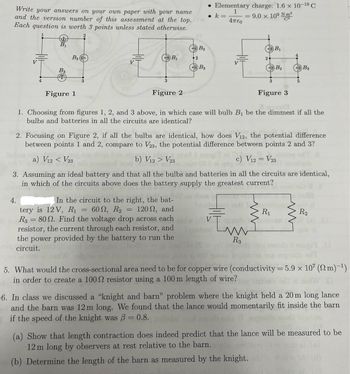
College Physics
11th Edition
ISBN: 9781305952300
Author: Raymond A. Serway, Chris Vuille
Publisher: Cengage Learning
expand_more
expand_more
format_list_bulleted
Question
I need help on question 4?

Transcribed Image Text:Write your answers on your own paper with your name
and the version number of this assessment at the top.
Each question is worth 3 points unless stated otherwise.
B₁
B2
B2
• Elementary charge: 1.6 x 10-19 C
k =
=
1
Απερ
=
9.0 × 109 N m²
B₁
B₁
2
2
B3
B2
B3
B3
3
4
Figure 1
3
Figure 2
3
Figure 3
1. Choosing from figures 1, 2, and 3 above, in which case will bulb B₁ be the dimmest if all the
bulbs and batteries in all the circuits are identical?
2. Focusing on Figure 2, if all the bulbs are identical, how does V12, the potential difference
between points 1 and 2, compare to V23, the potential difference between points 2 and 3?
a) V12 < V23
V23
b) V12 > Vol bourgi ai
c) V12 = V23
4.
3. Assuming an ideal battery and that all the bulbs and batteries in all the circuits are identical,
in which of the circuits above does the battery supply the greatest current?
In the circuit to the right, the bat-
tery is 12 V, R₁ = 60, R2 = 120, and
R3 = 80. Find the voltage drop across each
resistor, the current through each resistor, and
the power provided by the battery to run the
circuit.
R₁
R2
In
R3
5. What would the cross-sectional area need to be for copper wire (conductivity = 5.9 x 107 (2m)-1)
in order to create a 1002 resistor using a 100 m length of wire?
6. In class we discussed a "knight and barn" problem where the knight held a 20 m long lance
and the barn was 12 m long. We found that the lance would momentarily fit inside the barn
if the speed of the knight was ẞ= 0.8. boldal
(a) Show that length contraction does indeed predict that the lance will be measured to be
12 m long by observers at rest relative to the barn.
(b) Determine the length of the barn as measured by the knight.
al (s)
bid 1A (d)
Expert Solution
This question has been solved!
Explore an expertly crafted, step-by-step solution for a thorough understanding of key concepts.
Step by stepSolved in 2 steps

Knowledge Booster
Similar questions
- Problem 12 and 13 are togetherarrow_forwardA brother and sister are playing in the woods, when suddenly the brother realizes that they are separated. The last place he remembers seeing his sister is at a particularly large tree. The brother traveled d = 21.0 m at 8, 26.0 from the tree then turned and traveled de 11.0 m at 0₂= 140". Meanwhile, the i sister traveled ds = 17.5 m at an angle of 0-117 from the tree. The angles are given with respect to east with counterclockwise being defined as positive(Eigure 1) Figure d₁ 8₂ 1 of 4) > Part C-Distance to home After the boy has found his sister, they want to travel the shortest path home. If their home is located d, 75 m due north of the big treo, what is the magnitude and direction of the displacement from the siblings to their home, dpcH?(Eigure 4) Express your answers, separated by a comma, to three significant figures. Enter the angle measured counterclockwise from the positive x axis. ▸ View Available Hint(s) dBGH 0BGH Submit 195| ΑΣΦ. Η vec Review noturn to Assignment Provide…arrow_forwardwhy would it be +1/2gt instead of -?arrow_forward
arrow_back_ios
arrow_forward_ios
Recommended textbooks for you
 College PhysicsPhysicsISBN:9781305952300Author:Raymond A. Serway, Chris VuillePublisher:Cengage Learning
College PhysicsPhysicsISBN:9781305952300Author:Raymond A. Serway, Chris VuillePublisher:Cengage Learning University Physics (14th Edition)PhysicsISBN:9780133969290Author:Hugh D. Young, Roger A. FreedmanPublisher:PEARSON
University Physics (14th Edition)PhysicsISBN:9780133969290Author:Hugh D. Young, Roger A. FreedmanPublisher:PEARSON Introduction To Quantum MechanicsPhysicsISBN:9781107189638Author:Griffiths, David J., Schroeter, Darrell F.Publisher:Cambridge University Press
Introduction To Quantum MechanicsPhysicsISBN:9781107189638Author:Griffiths, David J., Schroeter, Darrell F.Publisher:Cambridge University Press Physics for Scientists and EngineersPhysicsISBN:9781337553278Author:Raymond A. Serway, John W. JewettPublisher:Cengage Learning
Physics for Scientists and EngineersPhysicsISBN:9781337553278Author:Raymond A. Serway, John W. JewettPublisher:Cengage Learning Lecture- Tutorials for Introductory AstronomyPhysicsISBN:9780321820464Author:Edward E. Prather, Tim P. Slater, Jeff P. Adams, Gina BrissendenPublisher:Addison-Wesley
Lecture- Tutorials for Introductory AstronomyPhysicsISBN:9780321820464Author:Edward E. Prather, Tim P. Slater, Jeff P. Adams, Gina BrissendenPublisher:Addison-Wesley College Physics: A Strategic Approach (4th Editio...PhysicsISBN:9780134609034Author:Randall D. Knight (Professor Emeritus), Brian Jones, Stuart FieldPublisher:PEARSON
College Physics: A Strategic Approach (4th Editio...PhysicsISBN:9780134609034Author:Randall D. Knight (Professor Emeritus), Brian Jones, Stuart FieldPublisher:PEARSON

College Physics
Physics
ISBN:9781305952300
Author:Raymond A. Serway, Chris Vuille
Publisher:Cengage Learning

University Physics (14th Edition)
Physics
ISBN:9780133969290
Author:Hugh D. Young, Roger A. Freedman
Publisher:PEARSON

Introduction To Quantum Mechanics
Physics
ISBN:9781107189638
Author:Griffiths, David J., Schroeter, Darrell F.
Publisher:Cambridge University Press

Physics for Scientists and Engineers
Physics
ISBN:9781337553278
Author:Raymond A. Serway, John W. Jewett
Publisher:Cengage Learning

Lecture- Tutorials for Introductory Astronomy
Physics
ISBN:9780321820464
Author:Edward E. Prather, Tim P. Slater, Jeff P. Adams, Gina Brissenden
Publisher:Addison-Wesley

College Physics: A Strategic Approach (4th Editio...
Physics
ISBN:9780134609034
Author:Randall D. Knight (Professor Emeritus), Brian Jones, Stuart Field
Publisher:PEARSON